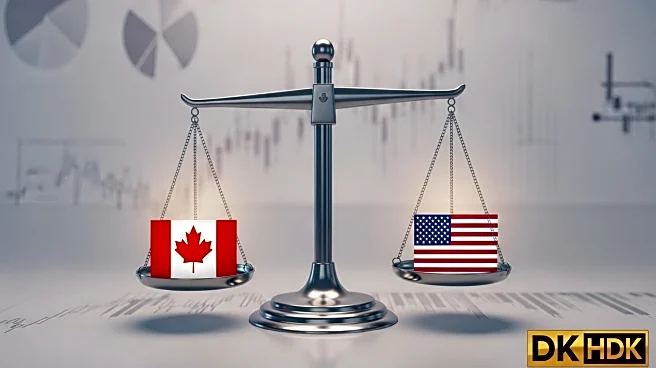What's Happening?
The U.S. dollar maintained its upward trajectory, marking its second consecutive week of gains against major currencies. This development follows the release of robust U.S. economic data, which has tempered expectations for further interest rate cuts by the Federal Reserve. The dollar's strength is attributed to better-than-expected consumer spending figures, which rose by 0.6% in August, surpassing the 0.5% forecasted by economists. Additionally, the Personal Consumption Expenditures Price Index, a key inflation measure favored by the Fed, increased by 0.3% last month, aligning with predictions. The dollar index, which tracks the greenback against a basket of currencies, fell slightly but remained on course for weekly gains. The two-year note yield, closely tied to Fed interest rate expectations, also saw a slight increase. These economic indicators suggest resilience in the U.S. economy, complicating the Fed's potential plans to ease interest rates.
Why It's Important?
The dollar's continued strength has significant implications for U.S. monetary policy and international trade. A strong dollar can affect the competitiveness of U.S. exports, making them more expensive for foreign buyers. This scenario could impact U.S. manufacturers and exporters negatively. Conversely, it benefits U.S. consumers by making imported goods cheaper. The Federal Reserve's decision-making process regarding interest rates is influenced by these economic indicators, as stronger economic data may deter further rate cuts. This situation could lead to higher borrowing costs for businesses and consumers, affecting economic growth. Additionally, the dollar's performance impacts global financial markets, influencing currency exchange rates and international investment flows.
What's Next?
The Federal Reserve will likely continue to monitor economic data closely to determine its next steps regarding interest rates. Market participants will be watching for any signals from the Fed about potential rate adjustments. The ongoing strength of the dollar may prompt discussions among policymakers about balancing economic growth with inflation control. Internationally, other central banks may react to the dollar's performance by adjusting their own monetary policies to maintain competitive exchange rates. The interplay between U.S. economic data and Fed policy will remain a focal point for investors and economists in the coming weeks.
Beyond the Headlines
The dollar's strength highlights broader economic trends, including the resilience of the U.S. economy amid global uncertainties. It underscores the importance of consumer spending as a driver of economic activity. The situation also raises questions about the long-term sustainability of the U.S. economic growth model, particularly in the face of potential global economic slowdowns. The Fed's actions will be scrutinized for their impact on inflation and employment, key components of its dual mandate. The dollar's performance may also influence geopolitical dynamics, as countries adjust their economic strategies in response to U.S. monetary policy.










